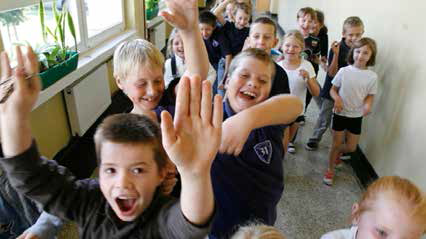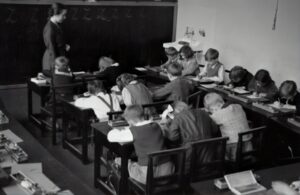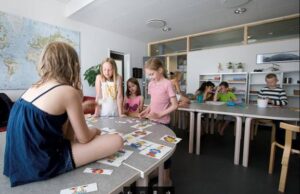
Teaching methods shape the classroom sound environment
Teachers of today have the shared goal of maximizing student engagement whilst maintaining a controlled sound environment. This has resulted in decades of innovation in educational approaches, classroom design and acoustic standardization. When additionally considering the influence of advancements in technological tools which have further augmented the field of education (e.g. blended learning) [1], the combined result of all these factors has been a complete redefinition of traditional roles and activities in the classroom as well as the use of space.
Building new classrooms or refurbishing old ones is extremely costly, so contemporary teaching methods are in many cases applied in classrooms that were designed for traditional lecture-based teaching. But the days when teachers deliver information and knowledge to be passively received by silent ranks of stationary students are almost over. And such a paradigm will surely not be missed; the lecture-based model has shown itself to be less effective in engaging students over alternatives [2], partly driving this contemporary rethink of how to fight boredom, inattention, fatigue and flagging attendance in the classroom.
 One benefit of the traditional lecture-based approach, however, was for the sound environment. Having a captive audience with only one person speaking at a time and zero peer-to-peer interactions likely produced a classroom with far less distractions and lower noise levels coming from within the school. Provided the learners don’t fall asleep, such an environment is highly conducive to auditory learning. However, as teaching styles have begun to shift away from that model, classroom noise has become a central challenge for the international education system to overcome in order to maintain sufficient levels of auditory perception and comprehension.
One benefit of the traditional lecture-based approach, however, was for the sound environment. Having a captive audience with only one person speaking at a time and zero peer-to-peer interactions likely produced a classroom with far less distractions and lower noise levels coming from within the school. Provided the learners don’t fall asleep, such an environment is highly conducive to auditory learning. However, as teaching styles have begun to shift away from that model, classroom noise has become a central challenge for the international education system to overcome in order to maintain sufficient levels of auditory perception and comprehension.
Modern trends in education increase classroom noise levels
Open plan classrooms were experimented with briefly in the 1960s and 70s and have experienced a resurgence of interest in recent years due to their ability to accommodate a variety of modern teaching approaches [3]. Additionally, the last decades have seen the development of more hands-on contemporary approaches such as the “flipped classroom“, in which learners are given online tools and resources to deliver the knowledge content of their classes at home, meanwhile, the classroom becomes a hive of activity in which learners are assisted by their educators in doing what traditionally was considered to be home-work. This is thought to enable the students to develop critical thinking skills, popularly known as 21st Century Skills, through problem-solving, discussions and collaboration under the guidance of the teacher [4]. Such an approach has led to reports of gains in student engagement as well as cautious optimism that this will translate into academic achievement in time (see [5] for a meta-analysis).

However, a central drawback of these approaches is that classroom noise often becomes unmanageable. Noise is detrimental to students and teachers’ health and wellbeing in a number of ways. For example, when classroom noise increases and teachers are forced to out-compete students vocally in order to be heard (the Lombard Effect [6]), vocal strain and dysphonia results, a medical condition affecting the voice that leads to poorer job performance, higher incidences of sick leave and resignation, as well as marked effects on teachers’ social lives (see [7] for a meta-analysis of these effects).
Meanwhile, we now know enough about how the peripheral and central auditory systems process speech throughout the lifespan as to leave no doubt that learners’ full potential simply cannot be unlocked under noisy conditions, regardless of age or background. The effects of higher noise levels on learners have been extensively researched and linked to a reduced capacity to hear what has been said [8], follow verbal instructions [9], remember what they have heard [10], understand what they have read [11] as well as a myriad of other effects (for reviews, see [12] and [13]). Although the direct consequences of a noisy learning environment are more pronounced in children, particularly those with special needs (e.g. hearing loss) [14], adult learners are also not immune to the effects of noise [15].
Although significant progress in mitigating these effects has been made through the development of international and national classroom acoustic guidelines, standards and recommendations (e.g. World Health Organization’s Environmental Noise Guidelines for the European Region, BB93, SS 25268 2007+T1 2017) which have been applied to refurbished as well as newly built classrooms, an entire rethink of how classrooms are designed may be necessary in order to really accommodate new teaching styles and optimize the sound environment they create.
Classroom design with the sound environment in mind
The redesign of learning spaces to accommodate such a paradigmatic shift in teaching methods has not yet happened in most schools globally, although change is on the horizon in the form of innovative learning environments (ILEs). Contemporary designers have started to deeply consider what primary affordances classrooms provide for learners, in order to design accordingly. The short-list of relevant environmental factors considers lighting, air quality and temperature, but also does not forget to include acoustics [16] in recognition of the central importance and necessity of successful speech transmission and comprehension in the classroom.
ILEs are highly compatible with new teaching approaches, and in fact describe themselves as “the product of innovative space designs and innovative teaching and learning practices” [17]. These spaces are optimized for “deep learning” (in contrast with “surface learning”), which can be thought of as understanding and placing what has been learned in context as opposed to just memorizing what is learned [18]. Due to the primary role of language in learning, what is prioritized in a deep learning space has to be speaking and listening. Therefore, the focus for ILE designers is to allow for productive sounds, the hum of activity that accompanies group work and discussion, while reducing disruptive noise. Design features that are implemented to accommodate these needs include sound-absorbent materials as a baseline for acoustic comfort, speech clarity and transmission, but also innovative ways of acoustically separating the activity spaces, such as the clever use of glass and other materials [19].
Ultimately what is needed is an environment in which speech transmission and cognition of what is heard are prioritized whilst simultaneously allowing for advances in technology and teaching styles and accommodating the widest possible range of classroom activities. This will continue to be the central challenge for designers of educational environments until no learner is left behind by the acoustic and spatial design of the places in which they learn, develop and grow.
If you are interested in more information, contact Douglas MacCutcheon here.
Sources
[1] Valiathan, P. (2002). Blended learning models. Learning Circuits, 3(8), 50-59.
[2] Delialioglu, Ö. (2012). Student engagement in blended learning environments with lecture-based and problem-based instructional approaches. Educational Technology & Society, 15(3), 310-322.
[3] Shield, B., Greenland, E., & Dockrell, J. (2010). Noise in open plan classrooms in primary schools: A review. Noise and Health, 12(49), 225.
[4] Tucker, B. (2012). The flipped classroom. Education Next, 12(1), 82-83.
[5] Chen, K. S., Monrouxe, L., Lu, Y. H., Jenq, C. C., Chang, Y. J., Chang, Y. C., & Chai, P. Y. C. (2018). Academic outcomes of flipped classroom learning: a meta‐analysis. Medical Education, 52(9), 910-924.
[6] Brumm, H., & Zollinger, S. A. (2011). The evolution of the Lombard effect: 100 years of psychoacoustic research. Behaviour, 148(11-13), 1173-1198.
[7] Byeon, H. (2019). The risk factors related to voice disorder in teachers: A systematic review and meta-analysis. International Journal of Environmental Research and Public Health, 16(19), 3675.
[8] Hall III, J. W., Grose, J. H., Buss, E., & Dev, M. B. (2002). Spondee recognition in a two-talker masker and a speech-shaped noise masker in adults and children. Ear and Hearing, 23(2), 159-165.
[9] Lewis, D. E., Manninen, C. M., Valente, D. L., & Smith, N. A. (2014). Children’s understanding of instructions presented in noise and reverberation. American Journal of Audiology, 23(3), 326-336.
[10] Ljung, R., Sörqvist, P., Kjellberg, A., & Green, A. M. (2009). Poor listening conditions impair memory for intelligible lectures: implications for acoustic classroom standards. Building Acoustics, 16(3), 257-265.
[11] Connolly, D., Dockrell, J., Shield, B., Conetta, R., Mydlarz, C., & Cox, T. (2019). The effects of classroom noise on the reading comprehension of adolescents. The Journal of the Acoustical Society of America, 145(1), 372-381.
[12] Shield, B. M., & Dockrell, J. E. (2003). The effects of noise on children at school: A review. Building Acoustics, 10(2), 97-116.
[13] Shield, B. M., & Dockrell, J. E. (2008). The effects of environmental and classroom noise on the academic attainments of primary school children. The Journal of the Acoustical Society of America, 123(1), 133-144.
[14] Crandell, C. C., & Smaldino, J. J. (2000). Classroom acoustics for children with normal hearing and with hearing impairment. Language, speech, and hearing services in schools, 31(4), 362-370.
[15] Klatte, M., Lachmann, T., & Meis, M. (2010). Effects of noise and reverberation on speech perception and listening comprehension of children and adults in a classroom-like setting. Noise and Health, 12(49), 270.
[16] Young, F., Cleveland, B., & Imms, W. (2019). The affordances of innovative learning environments for deep learning: educators’ and architects’ perceptions. The Australian Educational Researcher, 1-28.
[17] Mahat, M., Bradbeer, C., Byers, T., & Imms, W. (2018). Innovative learning environments and teacher change: Defining key concepts. Melbourne: LEaRN, University of Melbourne.
[18] Marton, F., & Säljö, R. (1976). On qualitative differences in learning: I—Outcome and process. British Journal of Educational Psychology, 46(1), 4–11.
[19] Cleveland, B. (2011). Engaging spaces: innovative learning environments, pedagogies and student engagement in the middle years of school. PhD thesis, Faculty of Architecture, Building and Planning, The University of Melbourne.
Author: Douglas MacCutcheon, Global Concept Developer for Educational Environments at Ecophon




